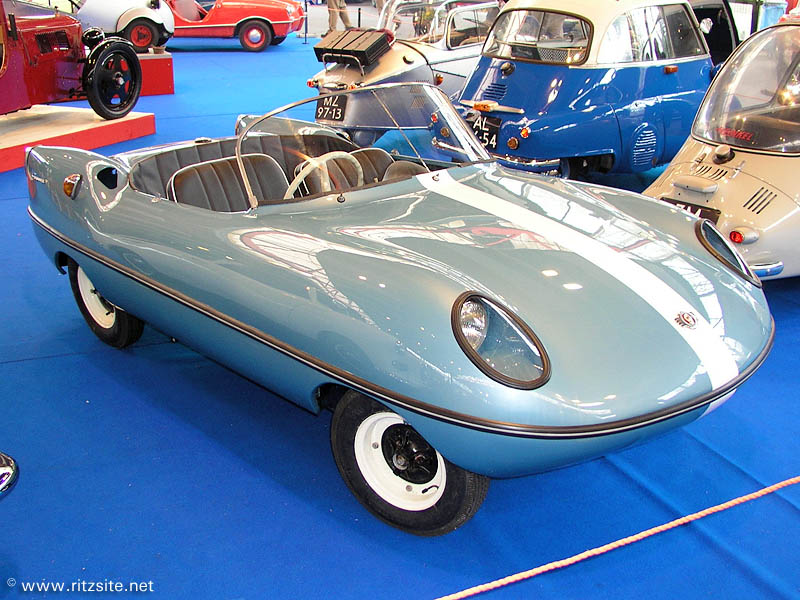|

Goggomobil Dart - roadster body by Buckle Motors - manufactured in 1959
It's a remarkable combination: world's largest island and one of world's most popular microcars. Hard to imagine these days but there was a time when the German Goggomobil microcars were sold by the boat-load in Australia.
In post-war Europe the microcars were born out of necessity. There was a shortage in materials since most of it was used to reconstruct damaged buildings and infrastructure and this made regular cars too expensive for the middle class market. Yet there was a strong desire for mobility and just enough money around to open up a lucrative market for means of transportation which were a step up from bikes and scooters and offered more freedom than public transport. This is where the microcar came in: tiny light cars powered by motorcycle engines offering just the most basic comforts and just enough speed not to be a safety hazard on the road.
Most microcars were manufactured by companies which were new to the automotive field; there were aircraft manufacturers, bike and motorcycle manufacturers, caravan manufacturers, engineering companies and also a manufacturer of farm equipment amongst the companies who presented microcars. That manufacturer of farm equipment was Hans Glas from Dingolfing, Germany. His company dated back to 1883 but presented its first road vehicle as late as 1951. This was the "Goggo" scooter which was an immediate success. It was followed by a range of microcars named "Goggomobil" in 1955, these were well-built and fairly practical and appeared more like reduced cars than covered over scooters, in contrast to most competitors. Thanks to these qualities the Goggomobil proved to be a big hit and it outsold and outlived practically all other microcars from that era until it came to its end by the hands of BMW, another German company who survived thanks to microcars, in 1969.
The success of the Goggomobil had an unexpected offshoot to Australia in 1958. Though the circumstances in Australia were much different from those in post-war Europe there appeared also to be a market for bargain priced small cars. Buckle Motors from Sidney were a car retailing firm with an interest in the production of fibreglass bodies. They had produced a number of sport coupes from Ford Zephyr components and self-developed fibreglass bodywork during the 1950s which proved to be of high quality but could only be sold at a loss. From 1958, inspired by the popularity of microcars in Europe, Buckle Motors started to import chassis and mechanical components of the Goggomobil from Germany and fashioned fibreglass replacements for the original steel Goggomobil bodies. This way an important part of Australian import taxes was avoided, which made for attractive prices and profits. The new Australian bodies looked similar to the original but differed in sizes and, more importantly, were 45.5 kg lighter. Some 5,000 of these locally assembled cars were sold under the "Goggo" brand name until the end in 1962.
The Australian Goggo model range saw an unique addition in 1959 when Buckle Motors presented the Dart, an open roadster designed by local engineer Stan Brown. It was a puny sports car along the lines of contemporary Lotus models constructed from fibreglass upper and lower tubs. Underneath there was the standard Goggomobil technology with 293 cc 2-cylinder 2-stroke 14.8 hp or 392 cc 2-cylinder 2-stroke 20 hp engines. The complete car weighing just 380 kg these modest engines powered the Dart to maximum speeds from 92 to 100 kph, not exactly blistering but still quite thrilling given the diminutive, almost toy-like size of the car. It was very attractively priced but was too much of a specialty car to sell in big numbers. Ultimately about 700 Darts have been made.
The end of the quirky Australian Goggo was spelled by the new Austin-Morris Mini which had found its way to Australia during the early 1960s. It was quite similarly priced to the Goggo but offered more interior space and better (4-cylinder 4-stroke) engines. Buckle Motors then switched to modifying Minis, but this never reached the scale of the Goggomobil enterprise. Especially the Dart remained as an icon of the short Australian microcar history and gradually became known to the rest of the world as the interest in the history of the microcar grew.
Currently the microcars of the post-war era enjoy a revival in popularity and there is a growing number of people taking an interest in them and restoring and collecting these dinky cars. The Dart has become a sought after classic, both in and outside Australia, and examples of it are found all over the world, epitomizing the microcar subculture in all its eccentricity.
If you want to know more about microcars I can recommend the site of the Bruce Weiner Microcar Museum, which offers lots of pictures and descriptions of the cars displayed at this unlikely museum located in Georgia, USA.
© André Ritzinger, Amsterdam, Holland
|
